Many homeowners desire a beautiful landscape but are often discouraged by the lack of time and money needed to create and care for the garden of their dreams. A pleasing, low-care, low-cost landscape is possible, however, with careful planning, appropriate plant choices, and thoughtful design. Following are four basic time- and money-saving strategies for residential landscapes:
- Start with a good design. Use simple geometric shapes in the hardscape to provide structure and repetition for organization.
- Know your plants. Learn about hardy plants with interesting forms and foliage that thrive in your area.
- Know your soil. Choose plants that are compatible with your soil, or enrich and improve your soil with compost in selected areas when necessary.
- Don't fight your climate or soil conditions. Learn to appreciate the perfect imperfection of nature. Don't waste time trying to control every weed or errant twig on a shrub.
The goal is to do less trimming, weeding, and fertilizing and use less water, energy, and chemicals. The tips below for low-care, low-cost landscapes include ideas for plant selection and organization as well as hardscape selection and design.
Consider the following when selecting plants:
-
Select Florida-Friendly plants (Figure 1). Drought-tolerant plants require less water, and pest-resistant plants need less time and fewer chemicals to prevent and treat pest problems. Choose plants appropriate for your area. Check the hardiness zone for cold tolerance, select long-lived plants that thrive in your soil conditions, note insect problems and susceptibility to disease, and consider sturdiness and wind resistance. Pay attention to plants that work well and repeat them in areas with similar conditions. Additional information about plant selection is available from your local county Extension office or at the Florida-Friendly website, https://ffl.ifas.ufl.edu/homeowners/publications.htm. Download The Florida-Friendly Landscaping™ Guide to Plant Selection & Landscape Design for a complete list of Florida-Friendly plants. The guide includes important information for each plant, such as height and spread, growth rate, soil pH requirements, soil moisture and light requirements, and salt tolerance.
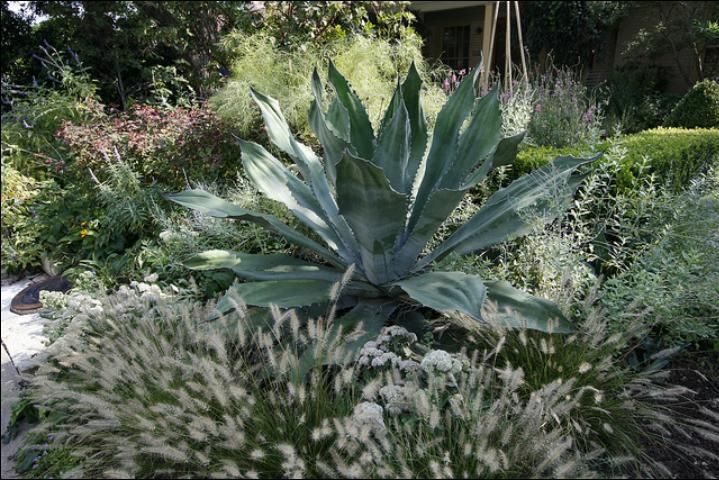
2. Base plant choices more on interesting foliage than flowers (Figure 2). Flowers often require time for deadheading, regular maintenance, and replacement. Look for large foliage with color and interesting shapes and textures. Variegated foliage often has stripes or splashes of red, yellow, and orange. Coarse-textured plants are attractive because of their large foliage and complex shapes. See the EDIS publication Landscape Design: Aesthetic Characteristics of Plants (https://edis.ifas.ufl.edu/ep433) for more information on using color and texture in the landscape.
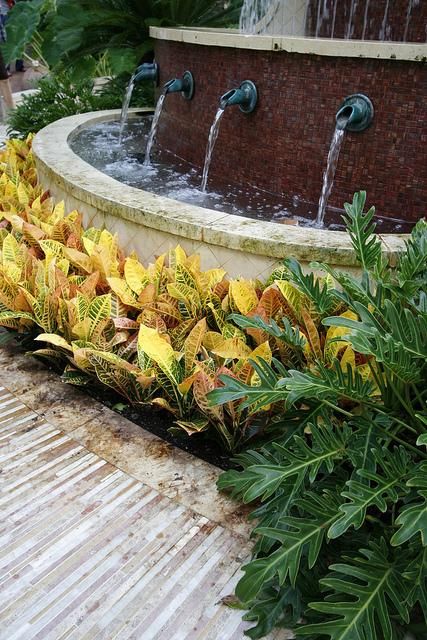
3. Use large plants with a wide spread, such as arching, cascading, or vase shapes (Figure 3), and low-growing plants with mounding or irregular shapes to cover large plant beds. Large plants allow for the use of fewer plants, and fewer plants require less maintenance. Substitute small shrubs for perennials; once they grow to their mature height and width, they need little maintenance other than an annual pruning. Low-growing, sprawling groundcovers cover larger areas and reduce the need for many small bedding plants (Figure 4).
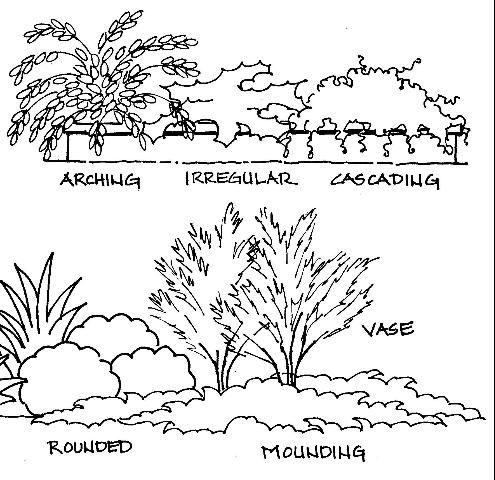
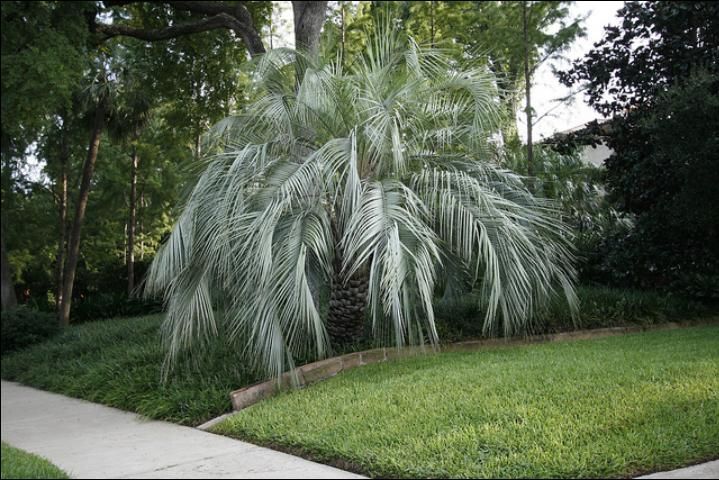
4. Choose evergreen plants to provide color and foliage all year (Figure 5). Many evergreens, including junipers and small shrubs, have a neat growth habit that requires little trimming. The needlelike foliage of some evergreens typically sheds very little, and the small needle litter can be left for mulch.
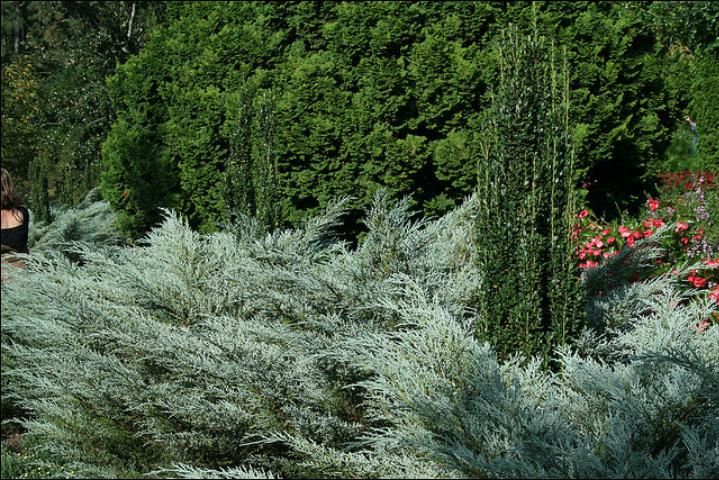
5. Use plants with a pleasing form. An attractive natural form (Figure 6) reduces the need to trim for appearance. Most plants need some annual pruning for health, but pruning techniques should maintain the natural plant form. For a neat and tidy look, choose plants that naturally maintain a tight and clean form. Or, if you prefer, choose plants with a loose, open form and let them grow naturally. Mixing the forms adds variety and interest to the landscape.
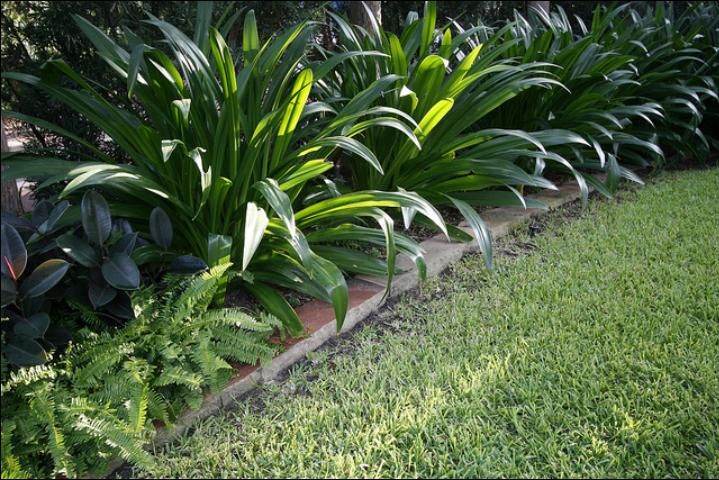
6. Conduct a soil test to determine the pH, fertility, and structure of the soil. This test is available through your local county Extension office. The best strategy is to use plants that naturally thrive in your soil type, particularly if you have a large garden. Amend and improve the soil with compost in the most visible planted areas, such as by the front door and patio areas. Use organic mulch, such as pine bark or pine straw, to keep soil moist, build soil structure, and insulate plant roots from winter cold and summer heat.
Consider the following when locating plants:
7. Use a simple plant palette with fewer, hardier plants. Select 10–15 plants to use in large masses and repeat them throughout the yard (Figure 7). Repeating the same types of plants in several plant beds simplifies the maintenance with the same care requirements. Group plants with the same water needs, and use drip irrigation when possible to reduce water use throughout the garden.
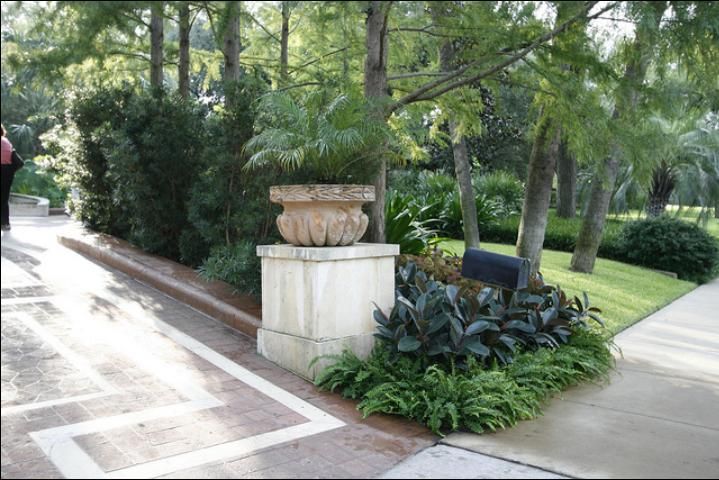
8. Slightly crowd plants together in the plant beds. Conventional planting techniques recommend spacing plants so they barely touch only at their mature size. For low maintenance, install plants so that they touch a little sooner but don't overlap too much (Figure 8). Most plants will not reach the high end of the height and spread growth range unless they are growing in optimal conditions. When drawing planting plans, a typical rule of thumb is to use 85% of the high end of the range for the plant spread. For example, a plant that has a range of 5–10 ft for the spread should be drawn at a spacing of 8.5 ft apart from center to center. This ensures that the plants will at least touch when they reach maturity. Dense foliage keeps weeds down from lack of sun. The shade of the foliage also prevents moisture evaporation from the soil, requiring less irrigation. Plants may need to be thinned at maturity if they do grow to the high end of their spread potential.
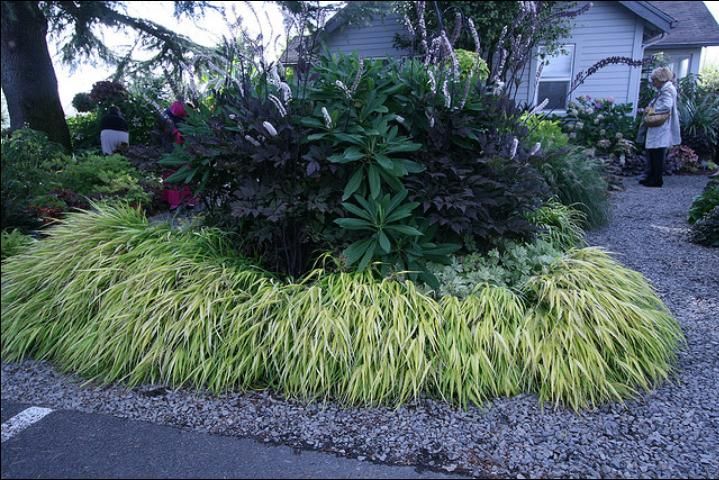
9. Fit the plant to the space. Use slow-growing, small plants in small areas and large, faster-growing plants in large areas (Figure 9). Consider the shape of the plant and the shape of the space. The more compatible the shape, the less time will be needed to trim the plant to fit the space. See the EDIS publication Landscape Design: Aesthetic Characteristics of Plants (https://edis.ifas.ufl.edu/ep433) for more information about shape and size design principles.
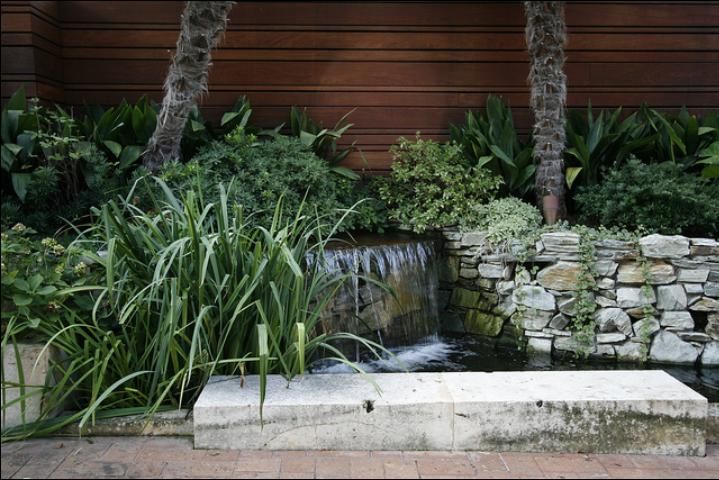
10. Use small trees or large shrubs to provide shade. Small trees shed fewer leaves, and large shrubs can be limbed up to provide shade for plants on the ground. Both provide a canopy that fills space and adds interest with height. Select trees with small foliage. Tiny leaves that fall off the trees will be hidden in the plant material and mulch below and will not require raking (Figure 10). Trees should also be placed to provide shade to air conditioning units and windows for energy efficiency.
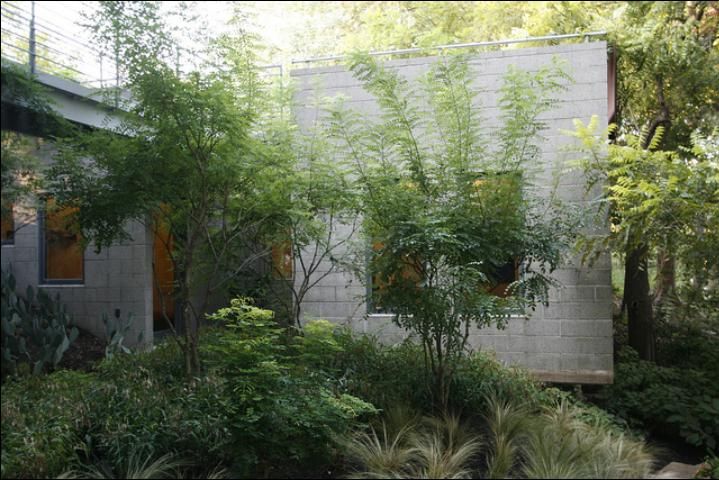
11. Move or remove unhealthy plants. Observe plants and watch for signs that they are not doing well. Some sick plants are in the wrong location, and the adverse growing conditions are contributing to the poor performance. Relocate to a more suitable location, if possible, or remove plants rather than waste time and money trying to keep the plant healthy.
Consider the following when selecting garden structures and ornaments:
12. Use hardscape and structures to maintain the structure and spatial organization of the garden as the plants change through the seasons and years. With structures, the garden will always have edges and mass to frame the plant material and give a finished look regardless of the seasonal condition of the plants (Figure 11).
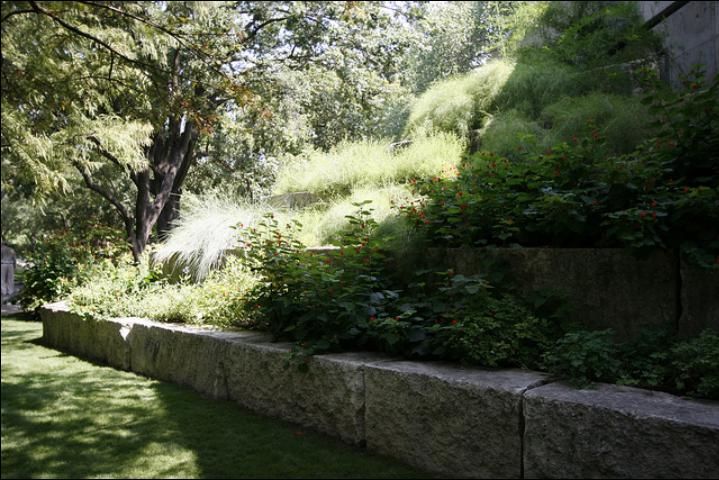
13. Use overhead structures to provide shade. Arbors, pergolas, and trellises can be used to create shade in areas where trees would create a maintenance problem with dropping leaves and twigs (Figure 12). Overhead structures are also useful in areas where trees should not be located, such as close to buildings and utility lines.
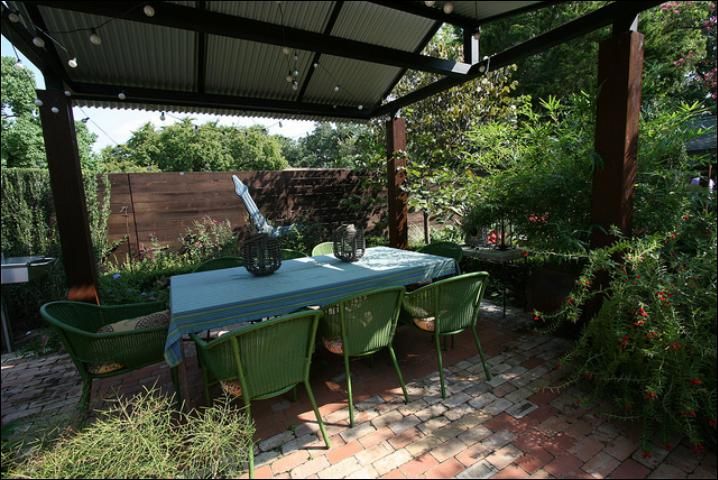
14. Use containers and planters in plant beds and on patios and decks. Containers add low-care year-round color and texture to the garden. Pots on patios and decks should have only one or two long-blooming or foliage plants for easy care (Figure 13). Containers in plant beds can be used for color and contrast with or without plants. Remember, however, that containers need more frequent watering, so have a water source such as a rain barrel nearby.
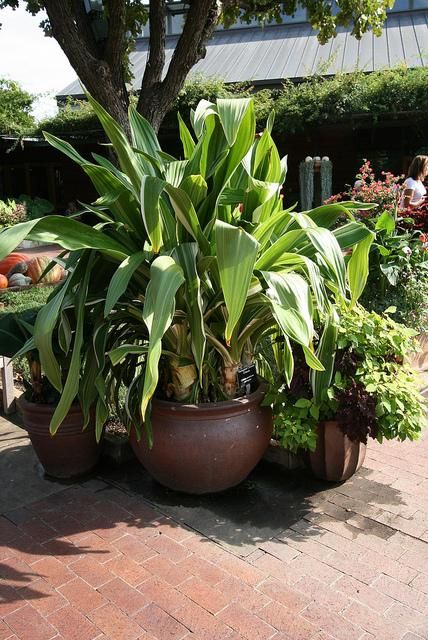
15. Use garden ornaments. Elements other than plants add color and texture to the garden, and maintenance usually requires no more than an annual cleaning. Most ornaments also serve a functional purpose as well, such as providing support for plants or homes for wildlife (Figure 14). Brightly painted bird houses or bird feeders add a splash of color, and trellises add texture and pattern. Carefully select larger ornaments appropriate for the design theme and avoid scattering many small, unrelated ornaments around the yard.

16. Select outdoor furniture with color and texture. Include rugs, curtains, and pillows to make a patio or porch more interesting and inviting (Figure 15). The patio furniture can set the style theme for the landscape and show your personal style and color preferences. Use durable outdoor materials and fabric that are easy to clean.
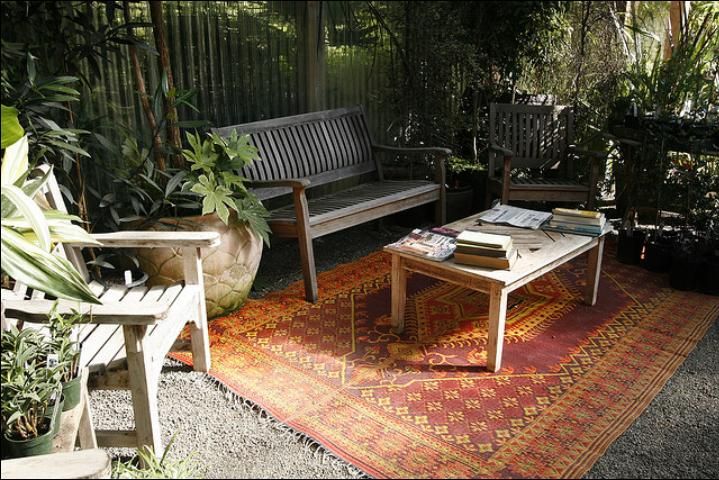
17. Choose easy-to-clean materials. Natural stone and other hardscape can be swept to save water (Figure 16). Plastics and metal are durable and have easy-to-clean surfaces. Shading a wood deck with a pergola or awning helps preserve the wood from water and sun damage. Composite wood is durable and does not require annual sealing or painting.

Consider the following when locating hardscape and structures:
18. Use several small patios or seating and relaxation spaces. Small, open areas organize the yard into functional spaces, and the surface materials require little care. Bricks, pavers, stone, and gravel are durable and long lasting. Ensure permeability by laying the pavers and stone on a sand and gravel bed over filter fabric that allows water to drain (Figure 17).
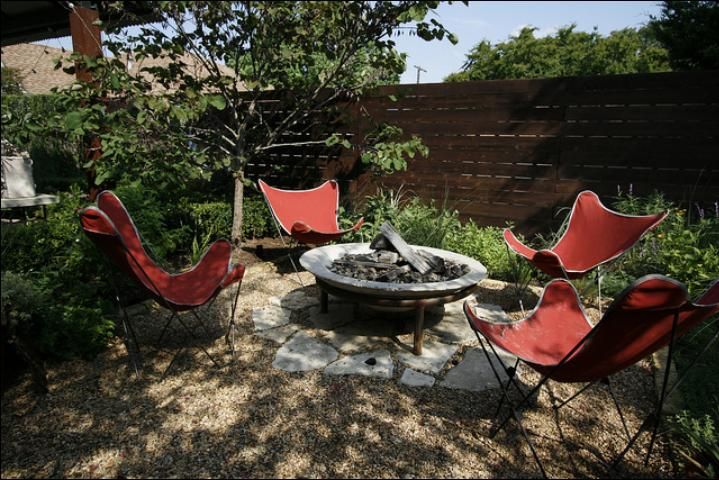
19. Use garden walls, low fences, and pathways. Short garden walls and pathways (Figure 18) between plant beds provide structure by creating spaces and separating beds for a neat look. Low retaining walls allow level changes that prevent erosion problems and separate beds.

20. Build in planters around decks and patios. Planters with short walls of bricks or stacked stones keep plants and mulch contained and off the deck or patio. Planters make it easier to water and trim the plants from the deck or patio (Figure 19). Plants are often healthier in raised beds where a good soil mix can be used and weeds and pests are easier to treat. Planters and raised beds also provide a variety of heights and patterns to separate and organize spaces.
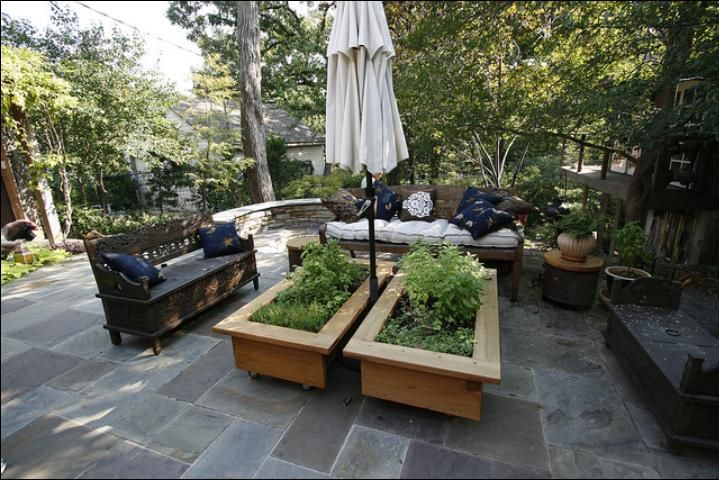
21. Reuse and repurpose materials. With creativity and imagination, many materials can be reused for the same purpose in a different form, or repurposed for a different function. Commonly reused materials are broken concrete from an old patio or driveway and concrete or metal pipe sections (Figure 20). Old garden gates and fences, wheelbarrows, and vintage sinks and buckets also make useful garden features.
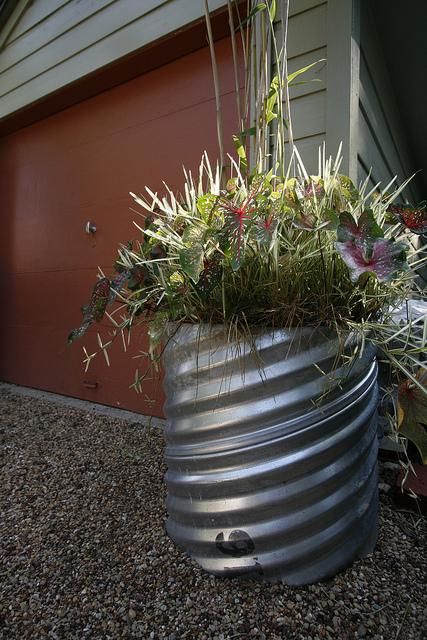
22. Hide or disguise unattractive areas. Some areas of the garden may be difficult to maintain despite your best efforts. Unattractive dog runs, blank walls, and work areas can be screened with a fence, lattice, or vines on a trellis. Low garden fences or walls can effectively hide areas where plants are difficult to grow or where utilities are located. Use large rocks, stone pathways, garden structures, and dry stream beds to cover bare spots.
Bringing it all together
Homeowners can use some or all of these ideas to create a low-cost, low-care garden. Figure 21 illustrates the layout of a typical yard that incorporates many of the ideas throughout the landscape. The design is unified through the repetition of circles—a simple geometric form that contrasts with the organic plant material. Pathways of gravel, groundcover, and mulch provide access throughout the yard, separate plant beds for a neat look, and organize spaces.
Elements in the backyard include a deck and three circular gathering areas that give structure to the planted areas. Reused concrete pieces laid in gravel provide a permeable hard surface for gathering off the deck, and the adjacent dining area includes a colorful umbrella and chairs to add variety and interest against the green foliage plants surrounding the circle of gravel. Another circular form holds an arbor structure that provides shade over a swing and vertical height for more emphasis in the corner. These hardscape areas and structures help to maintain the spatial organization of the garden during times of the year when plant material may be thin.
Containers on the deck and a few select garden ornaments add a punch of easy-care, colorful focal points to the yard. Raised, built-in planters help define the edge of the deck and make it easy to care for plants from all sides. A fence and large plants hide an unattractive dog run on the side of the house, and a trellis is used to hide a blank wall on the garage and utilities beside the house.
A simple plant palette is repeated throughout the yard, and plants are tightly spaced to prevent weed growth. Emphasis is on evergreen plants with a pleasing natural form that will not outgrow the space. Colorful foliage, interesting shapes, and coarse texture add to the aesthetic quality of the plants. Leaf litter is managed by using small trees or a large shrub with small leaves to provide shade.
Figure 22 shows possible plant material for North Florida, Figure 23 illustrates plant material for Central Florida, and Figure 24 shows suggested plant material for South Florida. All of the plant material is Florida-Friendly, and details about each plant can be found in The Florida-Friendly Landscaping™ Guide to Plant Selection & Landscape Design on the Florida-Friendly website, https://ffl.ifas.ufl.edu/homeowners/publications.htm. The overall effect is a well-organized and functional garden with a variety of low-care, aesthetically pleasing plants.
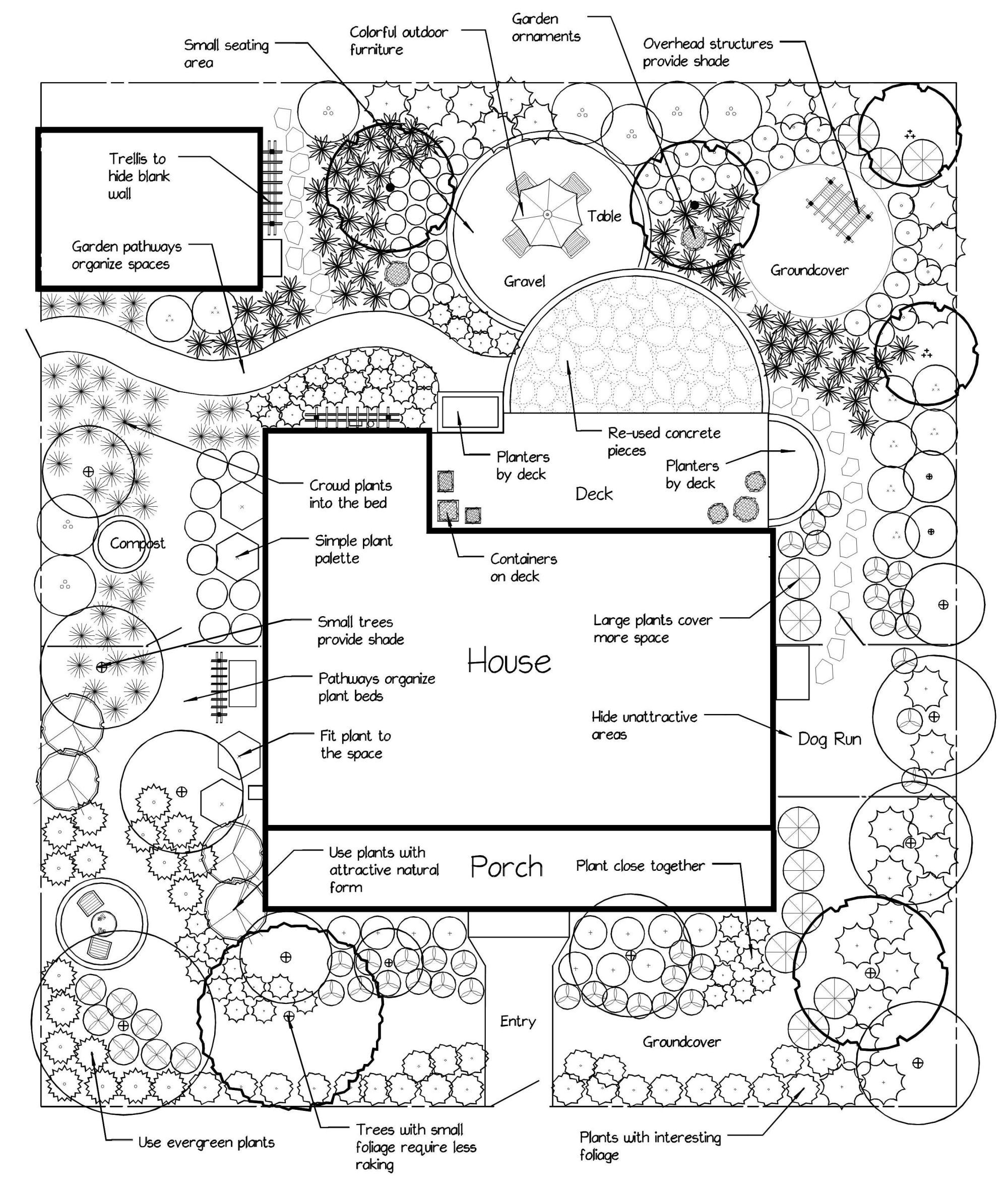
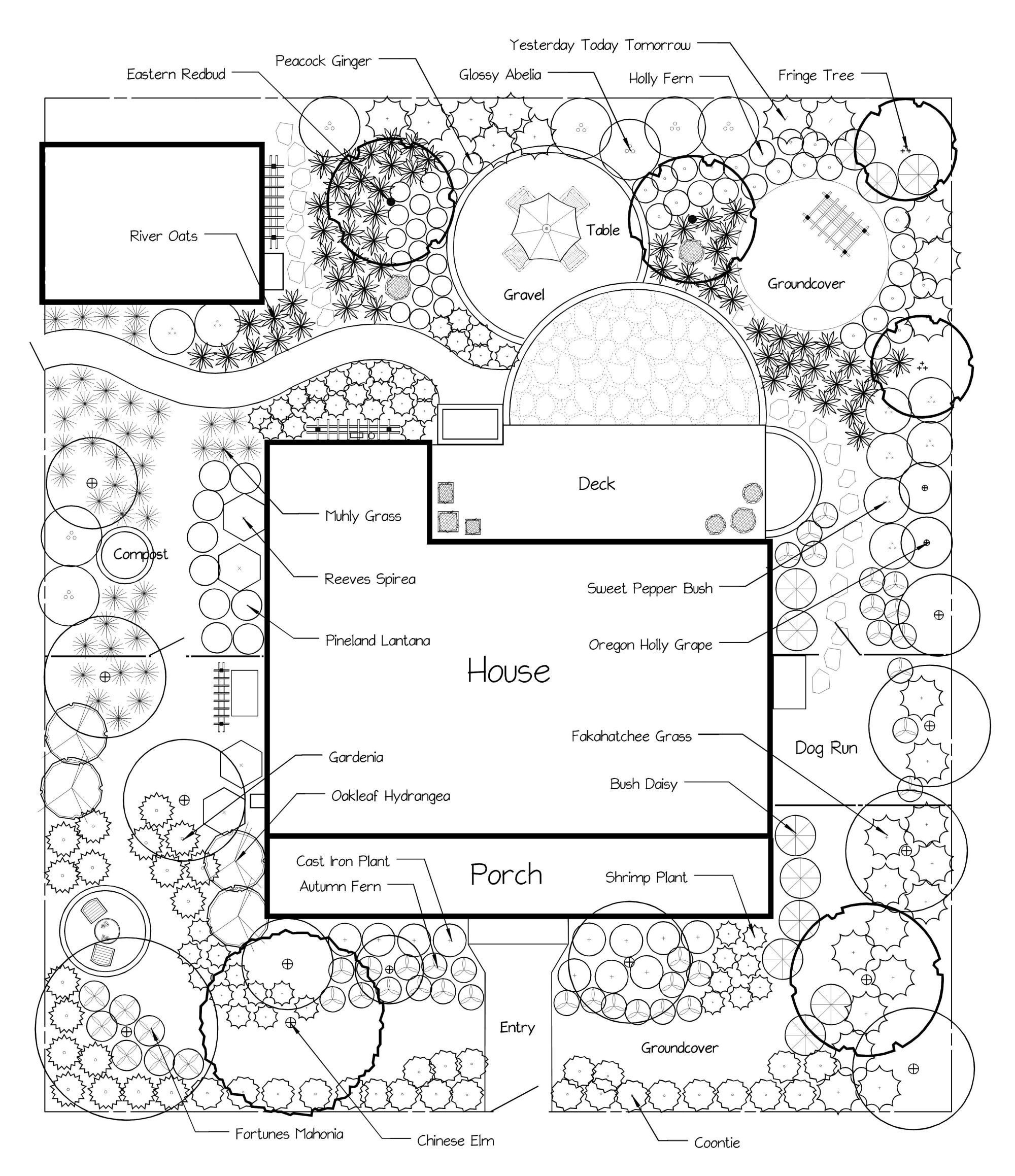
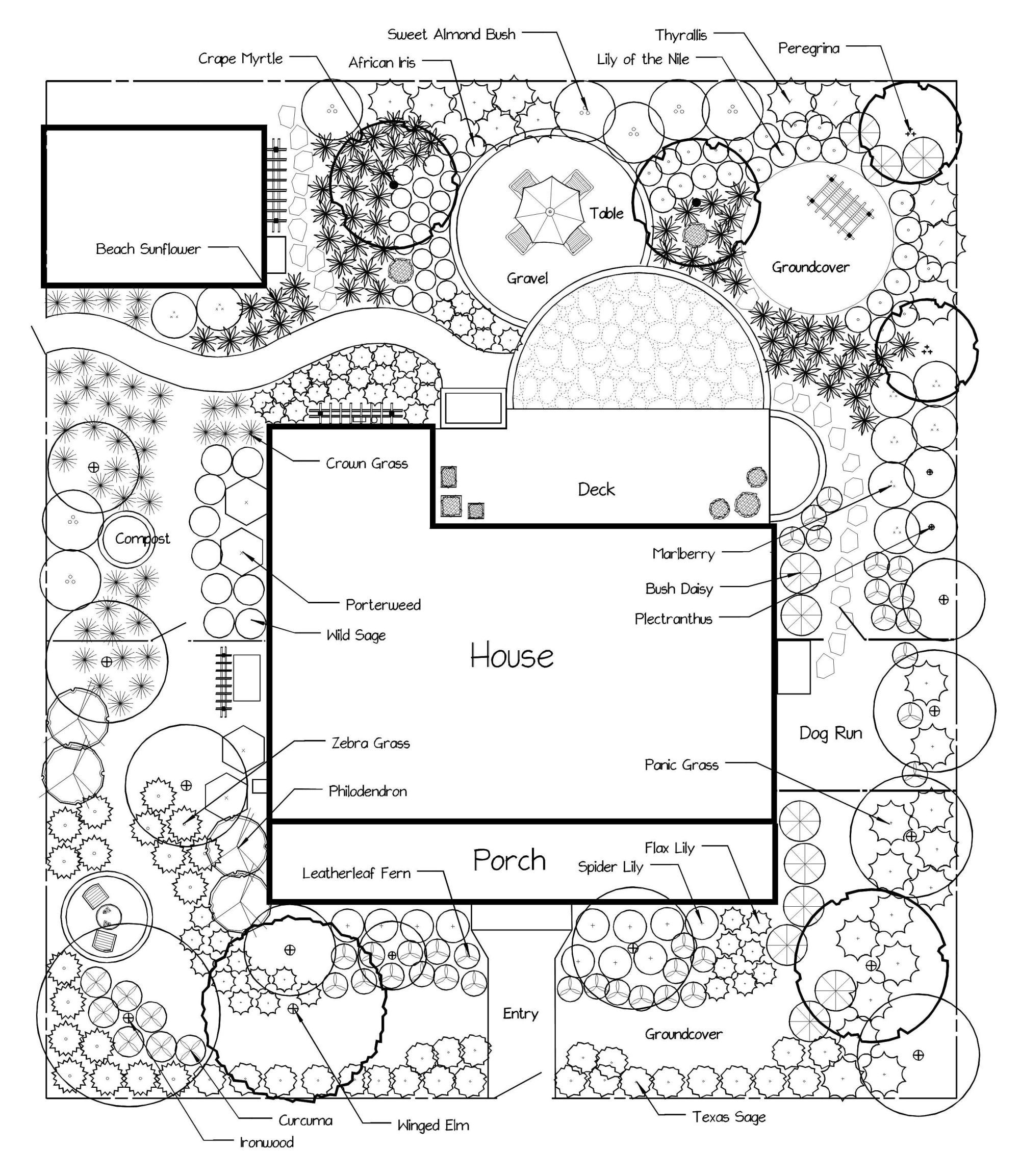

References
Easton, V. 2009. The New Low-Maintenance Garden: How to Have a Beautiful, Productive Garden and the Time to Enjoy It. Portland, OR: Timber Press.
Scarfone, S. 2007. Professional Planting Design: An Architectural and Horticultural Approach for Creating Mixed Bed Planting. Hoboken, NJ: John Wiley & Sons.
Smith, C., A. Clayden, and N. Dunnett. 2008. Residential Landscape Sustainability: A Checklist Tool. Malden, MA: Blackwell.
Walther, L. 2010. Florida Gardening on the Go. Gainesville: University Press of Florida.